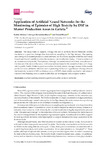Application of Artificial Neural Networks for the Monitoring of Episodes of High Toxicity by DSP in Mussel Production Areas in Galicia

Use este enlace para citar
http://hdl.handle.net/2183/26450
A non ser que se indique outra cousa, a licenza do ítem descríbese como Atribución 4.0 Internacional
Coleccións
- Investigación (FIC) [1605]
Metadatos
Mostrar o rexistro completo do ítemTítulo
Application of Artificial Neural Networks for the Monitoring of Episodes of High Toxicity by DSP in Mussel Production Areas in GaliciaData
2020-08-19Cita bibliográfica
Molares, A.; Fernandez-Blanco, E.; Rivero, D. Application of Artificial Neural Networks for the Monitoring of Episodes of High Toxicity by DSP in Mussel Production Areas in Galicia. Proceedings 2020, 54, 12. https://doi.org/10.3390/proceedings2020054012
Resumo
[Abstract]
This study seeks to support, through the use of Artificial Neural Networks (ANN), the decision to perform closings after days without sampling in the Vigo estuary. The opening and closing of the mussel production areas are based on the toxicity analysis of this bivalve’s meat. Sometimes it is not possible to obtain the necessary data for effective closing. If there is evidence of an increase in toxicity levels, “Precautionary Closings” on mussel extraction is done. A small error in the forecast of the state of the areas could mean serious losses for the mussel industry and a huge risk for public health. Unlike in previous studies, this study aims to manage the state of the mussel production areas, whilst the others focused on predicting the harmful algae blooms. Having achieved test sensitivity values of 67.40% and test accuracy of 83.00%, these results may lead to new research that involves obtaining more accurate models that can be integrated into a support system.
Palabras chave
Machine learning
Harmful algae blooms
Artificial neural networks
Harmful algae blooms
Artificial neural networks
Versión do editor
Dereitos
Atribución 4.0 Internacional
ISSN
2504-3900






